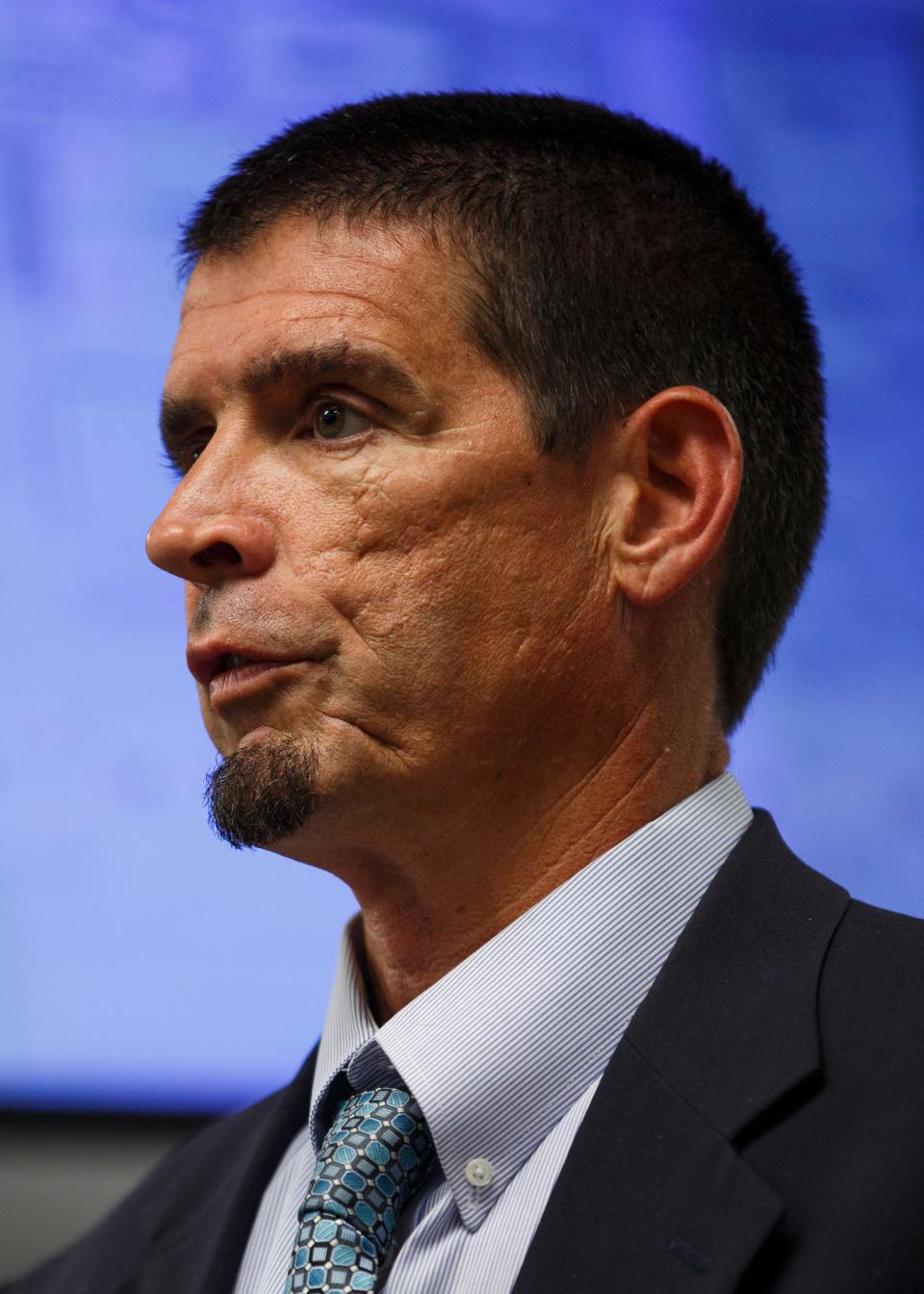Collier board continues heated hearing on proposal to build apartments in conservation area

With emotions and tensions running high, the Collier County Planning Commission continued a hearing on a developer's controversial proposal to build apartments in a conservation area at Fiddler's Creek.
The hearing will resume May 2.
While he planned to end Thursday's long-running meeting by 5 p.m. anyway, chairman Edwin Fryer cut off discussions a little sooner than expected, expressing frustration with so much contention in the room.
The developer of Fiddler's Creek wants to build hundreds of luxury apartments on a slice of a 600 acre-plus property, known as "Section 29," that many neighbors believed would remain untouched by residential or commercial development in "perpetuity," or forever.
Of 750 proposed apartments, 225 would be rent-restricted, to provide more affordable, workforce housing, addressing a critical shortage in the county.
Building the project will require changes to the county's growth management plan, as well as the planned unit development and the development order for Fiddler's Creek. Ultimately, county commissioners will have to make the tough decision on the petitions.
Including several breaks, the hearing before the planning advisory board ran for nearly eight hours before it was continued.
Multiple times, Fryer hit his gavel, or threatened to, in an effort to restore "decorum," with speakers talking over one another, and opponents chiming in from their seats, during expert presentations and board discussions.
The petitioner's local land use attorney Rich Yovanovich was left without answers, as the meeting ended abruptly. He sought clarification on the planning commission's request for a written brief on three points from him, and an opposing attorney, before the board meets on the matters again. One of the points involves the county's ability to give special treatment to projects with affordable and workforce housing, by policy, not law.
Earlier: Proposal to build apartments in a conservation area at Fiddler's Creek sparks concern, ire
More like this: 'Nothing more than a bait and switch': Kalea Bay developer wins right to build higher tower
Affordable housing targeted at essential workers
The developer, Naples-based Gulf Bay Group of Cos., has agreed to set aside 15% of the apartments for households earning 80% or less of the county's area median income, and another 15% for those making 100% or less of that amount.
The county's median income now tops more than $100,000 for a family of four. The median represents the amount in the middle, with half earning more and half making less.
At the 80% or less threshold, a single renter could make more than $55,000 a year and still qualify for the affordable housing. A household of four could earn more than $79,000.
The affordable housing is designed to serve essential workers, such as teachers, nurses, firefighters and police officers, as well as military veterans. County staff has recommended approval of the project, primarily based on that public benefit, despite its controversial location.

Conceptual plans for the apartments show a four-story complex (over parking), with multiple buildings, at a zoned height of 55 feet and an actual height of 69 feet, with access off what's now a narrow flood-prone road. The road would have to be extended through preserves to reach the new development.
Opponents have characterized the buildings as "high-rises," arguing they'd be incompatible with surrounding neighbors, and would be a broken promise by the developer, with a recorded conservation covenant covering the site.
The closest neighbors include owners of single-family homes, some of whom back up to the preserve.
The roughly 50-acre development site is also close to environmentally sensitive properties, such as the 7,271-acre Collier-Seminole State Park, one of the largest mangrove swamps in the world, and the Rookery Bay Reserve, which protects coastland lands, water and wildlife.
Today, the tallest building in Fiddler's Creek are the developer's corporate offices, at three stories.
If the apartments are allowed, the developer has agreed to raise and add more drainage to the rural road, known as Auto Ranch, the street that will be brought to the project's door. Other commitments include putting a sidewalk on one side of the road, and a bus stop where the road intersects with U.S. 41 East.
"We are absolutely planning on building all of this," Yovanovich said, and on the developer's dime.
Joe Schmitt, the planning commission's vice chairman, recused himself from a vote because he's served as a senior adviser to an environmental permitting consultant used by the developer.
Still, the commissioner offered input at the hearing, based on his expertise on permitting and enforcement issues involving the federal Clean Water Act and Endangered Species Act. Although he lives at Fiddler's Creek, he emphasized he had "no dog in the fight," but wanted to help the board by providing information.
Conservation lands promised in exchange for more development
In 2015, the Army Corps of Engineers determined development in new areas of Fiddler's Creek might harm Florida panthers and Florida bonneted bats, both classified as endangered species. The U.S. Fish and Wildlife Service found the construction would result in the loss, or "incidental taking," of nearly 719 acres of panther habitat.
To address the environmental concerns, Gulf Bay committed to set aside 614 acres of preserves in Fiddler's Creek, much of it in Section 29. To make up for the rest of the impacts on wildlife, the developer agreed to buy credits in a mitigation or conservation bank, a widely used tool to restore or enhance protected wetlands offsite, when it can't be done – or isn't as environmentally beneficial – on site.
Wayne Arnold, the project's planner with Q. Grady Minor & Associates, told the planning commission the project is largely driven by the developer's desire to build affordable housing to help address the dire need, and that building it anywhere else in Fiddler's Creek would be difficult, if not impossible.
The size and location of the project, and the inclusion of market rate apartments, are what make it economically feasible without subsidies from the county, he said.
Further, Yovanovich pointed out the apartments are planned on an old farm field.
Fiddler's Creek, he said, has an approved density of 1.53 dwelling units per acre, and the addition of the apartments would result in a density of 1.72, across the master-planned community of thousands of acres.
"That is not an exorbitant number," Yovanovich said.
With the change, the allowable number of single- and multifamily homes, including the apartments, would increase from 6,000 to 6,750.
The site the developer wants to build the rental housing on is designated for a park or recreational uses, which could include everything from a golf course to an equestrian center, and instead the developer wants to build apartments, Yovanovich said.
"This is not environmentally sensitive land," he insisted.
Frustrations voiced at hearing over unanswered questions
At times, Commissioner Robert Klucik, in particular, became angry and frustrated with Yovanovich, and others on Gulf Bay Group's development team, and a county attorney, when he felt he wasn't getting satisfactory answers to his pointed questions.
He peppered the development team with questions, including why the site made sense. He said the project seemed to be sloughed into an area that appeared inappropriate for housing, especially multifamily housing, and would unfairly burden its closest residential neighbors, including some who don't live in Fiddler's Creek.
The site sits outside of Fiddler's Creek's main gates, away from its primary clubhouse and golf course, and more expensive homes and valuable real estate on the opposite side of Collier Boulevard, which would see little, if any impact from the proposed the development.
As for visual impact on its neighbors, Arnold argued it would be minimized, with larger buffers and more lush landscaping planned than required by county code to soften views of the apartment buildings from neighbors' backyards. To the north, where there have been many complaints, the project would sit more than 500 feet from the closest residents in Royal Palm Golf Estates, or more than a football field away, he said.
County code requires less than a 35-foot setback.

Much of the discussion at the hearing centered around the appropriateness of the location, and the history of the developer's promises not to build housing on the land.
The covenants were required to build in the final sections of Fiddler's Creek – made up of the eastern part of Oyster Harbor and the entirety of Estancia. Those plans included up to 1,650 single-family and multifamily homes, a golf course and commercial uses, such as a grocery store, on 804 acres, including wetlands.
Several commissioners asked why it took Gulf Bay so long to record the protective covenants. In answer, Tim Hall, the company's environmental consultant, said, in part, it wasn't done until years after required by the Army Corps because the developer was in active negotiations with federal agencies to modify the conservation area, to allow a carve-out for development in part of Section 29.
The developer recorded the covenants only after receiving a notice of noncompliance.
That didn't sit well with Klucik and others on the planning commission. The noncompliance, he said, seemed blatant, obnoxious, and potentially unlawful.
In answer, Hall disagreed with the characterization, saying Gulf Bay was in communication with federal agencies all along, and when pushed to record the covenants in 2022, it did so.
Federal approvals still needed to allow construction
Even if the county approves the developer's petitions for the apartment complex, Gulf Bay still needs a thumbs up from federal agencies to be able to build it. With the permit from the Army Corps that's tied to the protective covenants now expired, the developer recently learned it would have to apply for a new permit.
Earlier this year, the Fish and Wildlife Service rejected Gulf Bay's request to modify the agency's opinion, which required the preservation of Section 29, in part due to the expiration of the Army Corps permit.
Gulf Bay sought to release 57 acres from the agreed-upon protection area, so it could build on them.
In its letter of denial, the Fish and Wildlife Service described the land as of "high ecological value to several species, including Florida panthers, Florida bonneted bats, andAmerican crocodiles," and as important in protecting the watershed of the Rookery Bay NationalEstuarine Research Reserve.
Despite the letter, Yovanovich said the Fish and Wildlife Service had expressed a willingness to grant the developer's request, if Gulf Bay is willing to pay big money to "go buy" 120 acres of land in Glades County for environmental protection. The cost: $1.6 million, he said.

More arguments to come from opponents
The opposition began, but didn't finish, making its case against the project.
Attorney Gary Oldehoff, a civil and land use attorney, who represents several of the homeowners fighting the apartments, said the planning commission's decision on whether to recommend in favor of the project should come down to "common sense."
He argued the apartment complex didn't make sense in the chosen location for myriad reasons, including the promise not to build residential or commercial buildings on it, which his clients relied upon when they bought their homes.
"Their property rights are going to be effected by this, not only the folks that live in Royal Palm Estates, but on Auto Ranch Road," Oldehoff said. "My God, the people on Auto Ranch Road, this is going to destroy that hamlet."
While county staff is recommending approval, he questioned compatibility, saying it seemed the affordable housing component outweighed other factors, including environmental and traffic concerns, and lamented it shouldn't trump everything else.
More opponents are expected to speak at the next hearing, with some ceding their time to others. Dozens of angry residents attended the hearing.
Mike Bosi, the county's planning and zoning director, told the planning commission he wouldn't support the project without affordable housing, which the county commission has pushed as "paramount."

He offered up statistics to demonstrate the need. Among them: Recent studies have shown nearly 50,000 households are cost-burdened in Collier County, meaning they spend more than 30% of their income on housing expenses – and nearly half of those households are deemed severely cost-burdened, spending more than 50%.
Additionally, Bosi noted that nearly 53,000 people commute to work from outside of Collier daily because they can't afford to live in the county, which puts more traffic on the roads, causing more congestion. He emphasized that many employers in the county are still struggling to hire and keep enough workers because housing is so expensive, hampering economic growth.
"It's no blame for one individual," Bosi said. "It's just we have not kept pace with the amount of demand."
This article originally appeared on Naples Daily News: Hearing not over on plan to build in a conservation area in Collier

